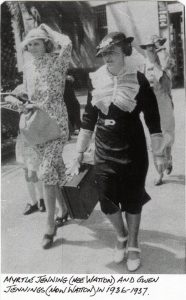by John Watton
In the display shed at the Riverstone Museum is a beautiful display case that houses a collection of tools. The case was designed and built by John Watton and Graham Britton. In 2016 Graham convinced John to tell the story of the Watton family and his career.
Lyle Edward John Watton was born in Ryde on 14th May 1903 and was one of six children born to Charles and Harriet Watton of Ryde/Eastwood.
Charles’ father Henry (originally from Hampshire, England) arrived in Australia in the 1850s and bought a large parcel of land in Eastwood. He developed a good size portion of the land into an orchard (peaches, plums, nectarines). Some years after Charles was born (1863) he was able to work with his father on the orchard until Henry’s untimely death in 1899.
Charles continued with the orchard and had the help of his three sons, Vic, Merv and Lyle for a short period of time until his death in 1916. Lyle was only 13 years old at this time. The three sons then took on the job of being orchardists. Lyle left in 1921 to seek other work when he was 18 years of age. Vic and Merv worked as orchardists for several years thereafter.
Lyle (known as Sam) after leaving the orchard sought work at the Riverstone Meat Works (1921-1922). His job and the period of time he stayed is unfortunately not known to us. A photograph of his workmates, Tommy Walland and Bertie Keegan is shown below.
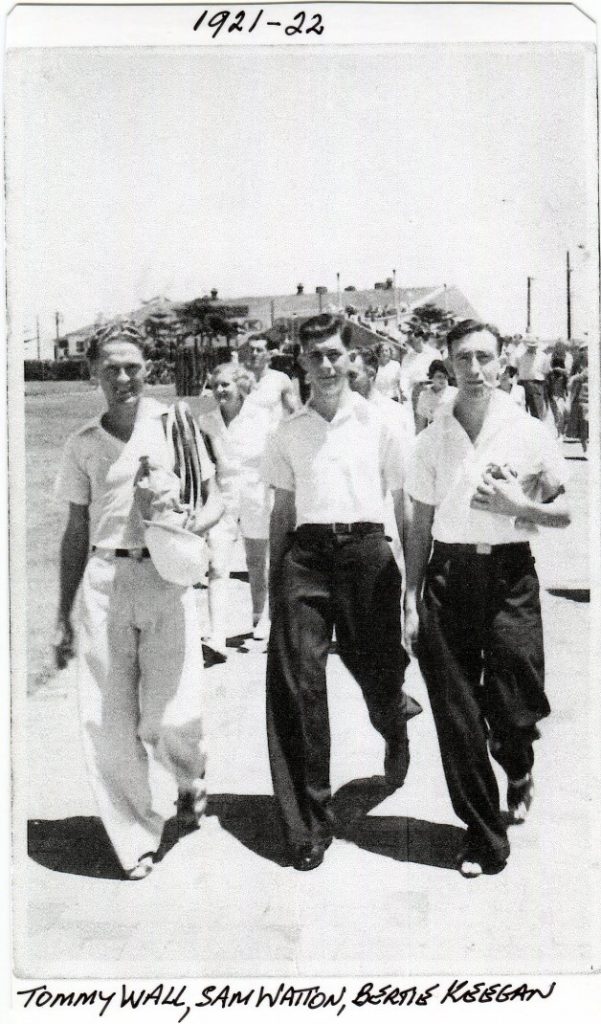
After leaving the meatworks job he returned to Eastwood and then took up a job in Sydney as a Paper Ruler and remained in that job until 1937. A Paper Ruler is a person who can set up, operate or tend paper goods machines that perform a variety of functions, such as converting, sawing, corrugating, banding, wrapping, boxing, stitching, forming or sealing paper or cardboard into a product.
Sam again visited Riverstone during the early thirties to see his two sisters, Myrtle and Ennis whom married two Riverstone gentlemen. Myrtle married Gordon “Dave” Jennings and Ennis married Bob Davis in 1933. We believe it was about this time that Sam met Gordon’s younger sister Gwen and a relationship developed and flourished from thereon and on 14th December 1937 they were married. Sam then moved to Riverstone permanently.
Gwendoline (Gwen) Helena Watton (nee Jennings) was born in Wyong NSW on 3rd July 1912 and was the youngest of six children born to parents Robert Charles Jennings (whose occupation was a sawyer) and Helena Bridget Smith (whose occupation was a housemaid). This was Charles’ second marriage – his first wife bore three girls and a boy.
Gwen and family remained in Wyong for nine years before moving to Richmond in August 1921 and then finally moving to Riverstone in June 1926. The family’s small house was situated on about five acres in Hamilton Street approximately opposite Ark Place. It was hard to imagine how such a large family lived in a home of this size, particularly when it only had two bedrooms, a lounge or sitting room and kitchen in the main building and laundry outside.
Gwen’s occupation before marrying Sam was a housemaid at home and at the old Riverstone Royal Hotel. The time she was employed there is unknown.
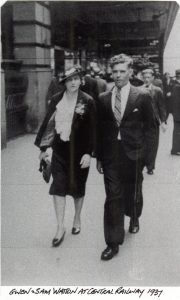
After Sam and Gwen (my Mum and Dad) married they lived in the little house in Hamilton Street for approximately four years. (Mum’s brothers and sisters had moved out by this time except her parents.)
When I was very young Mum related an event which happened in this house during her teenage years. One day a postman arrived at the front door during an electrical storm. She opened the door after hearing the knock and stepped briefly outside when a bolt of lightning shot through the open doorway, down the hall and out the back door striking their milking cow and killing it.
Another story she told me was when her father caught a crow, he slit its tongue and over a period of time taught it to talk.
Mum and Dad moved out of the little house in 1942. My sister Norma was born in 1938, I was born in 1939 in the little hospital in Garfield Road, now a doctor’s surgery. I was only three years of age but still remember the “big move” from Hamilton Street down through the bush to our “new home” in Piccadilly Street. Mum was wheeling a pram with my baby sister June in it (born 1941) and Norma and I were walking beside her. Dad was leading the way with a 6’0” roll of chicken wire on his shoulder. The little house was subsequently demolished several years later.
This “new” home was an old weatherboard cottage rented from Arthur Britton and consisted of two bedrooms, a lounge room (later to become another bedroom), kitchen, two small store rooms, a laundry room separated by a breezeway and a large shed in the back yard, situated on a large block of land. A few scattered houses could be seen from our house, namely, Schofield’s, Green’s, Drayton’s, Wheeler’s, Stephenson’s (Jockey’s old place).
I loved this old place and it became our home for the next 10-11 years. Alan (1943), Gwenda (1946) and Colin (1949) were born whilst living here.
As soon as we settled in, Dad built his chicken pens and roosts around the big shed then bought some laying hens and a rooster. From that time onwards we always had a good egg supply and eventually some young chicks. He would also buy day old chicks from Jack Marx up in McCulloch Street, rear them up and slaughter them at Easter and Christmas time.
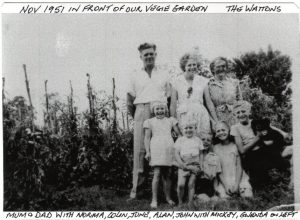
My father’s love for the garden was endless and he worked the spare block beside the house (house and shed being built on one side of the block) in the hours he was not working at the Meatworks, to become a great vegetable garden. This spare block was devoid of everything except grass, weeds, a mandarin tree and a large mulberry tree. Blocks of land along Piccadilly Street were originally surveyed with 36’ frontages. Our block was two blocks joined together.
Initially Dad spent hours, days and then months to develop this block into the garden he wanted. All digging was done by pronged hoe, fork and spade into a reasonable depth of top soil. He built himself a “billy cart” with long shafts each side and would go out into the paddocks surrounding our house and fill it with cow manure. This manure together with the chook poo that the fowls provided, enabled him to fertilise the ground to become rich soil.
Dad planted and grew tomatoes, (red marios – beautiful large reds and full of flavour) beans, peas, potatoes, broad beans, carrots, watermelons etc. year round and to suit the seasons. This virtually made us self sufficient and all this was being done whilst earning a living at the Meatworks.
We grew the freshest and best vegies in town (others would dispute this such as Uncle Gordon (Dave Jennings)) but Dad always had a spirited view and did his best at all times and with great results. When tomato growing, he would take an axe into the bush and cut down suitable saplings to be used as stakes to support the plants and bring them home on his shoulder.
At times when tomatoes and beans were abundant in our garden, Dad would sell a bucket of tomatoes for two shillings and beans for one shilling a bucketful.
All the time this was going on our Mother looked after all housework including cleaning, washing in an old copper, ironing, pegging out on lines stretched between posts and supported by bush poles, and looking after us at the same time.
When Easter came Dad would slaughter his fattened fowls however the plucking and gutting fell into Mum’s hands up to a stage when I was old enough to do both of these jobs. Norma, June and Alan helped with the plucking.
It was hard work for Mum in the 1940s, particularly when we were of primary school age in making sure we were properly attired and clean. I remember she would lay-by most things she required for the house and us as needed. Mostly payment would be made from endowment monies received from the government.
We certainly had the biggest and best mulberry tree in town. When in season all the kids around the area would come to our place with their little billy cans, climb the tree and pick their own berries. A lot were eaten before the billys were filled and taken home.
Piccadilly Street in the early years was virtually a horse and sulky track, rough and muddy in the wet, dry and dusty at other times. Other named streets were mostly tracks but we loved it and it gave us all the freedom in the world living there.
There was so much open land around our house and all of us – boys and girls would mix with other kids and explore the bush, creeks etc. catching crayfish, bird nesting, picking mushrooms and blackberries, trapping rabbits, fishing for whatever was available around the area as well as playing various types of sports on our homemade fields of contests.
For example, we would clear and level the ground by hand to build a cricket pitch; go to the bush and cut down suitable trees to use as goalposts and rails for our football games; dig out ground and fill it with sawdust carried from Dunstan’s Sawmill for long jumping, install posts and rail for high jumping. Kids around our area would come around to play. All this done without costing money (we had none anyway) and held us in good stead for sports later on, particularly with cricket and rugby league.
Dad loved having a small flutter on Saturday’s racing in Sydney and worked for Cecil Alcorn and Jessop Stockwell (SP bookies at the time) looking after the ‘tips’. i.e. Punters would try and pick the winners of each race and put in two shillings for the afternoon. At the end of the day the punter with the most points would win the ‘pool’. Neale Becke and I would hang around and would become the ‘runners’ for Cecil and Jessop when a large bet or bets were placed they would ask us to ride down quickly into town with a note to lay off these bets with other S.P. bookies. We would be paid two shillings per ride into town.
By 1952 Dad had saved enough money to buy a block of land in Mill Street. The block was one of several surveyed in a paddock owned by Fred and Frank Sullivan. The first job he did was to fence
the two sides and rear with split posts, rails and palings and I was helping him. Mainly this work was carried out on weekends. After fencing was completed Dad signed a contract with W. McNamara Pty. Ltd. to build a new house. This was completed in 1953 and we again had the big move to our wholly owned home.
In the meantime Dad was still working in the egg pulp department at the Meatworks and remained in that job until it was eventually closed. He then became a shift worker loading beef carcasses onto refrigerated rail wagons. At sometime thereafter he became a permanent night loader doing exactly the same type of work. A few of his mates at that time working with him were “Sonny” Johnson and Les Teale, Les Britton and Bruce (Bats) Johnson – others I can’t remember. He would leave for work about 2.45pm, come home for dinner at 8pm and return to work until the shift was completed. These working hours suited Dad because it allowed him to work during the morning at home mainly developing a fantastic vegie garden, doing as before in Piccadilly Street.
Mum in the meantime did everything as before but she liked to look after the flower gardens.
Of course there were recreational times in our early years. Mum and Dad would treat all of us to the Royal Easter Show and the Hawkesbury Show each year and we would certainly look forward to it and especially to buy some sample bags on offer. Travelling in these times was always by train and bus.
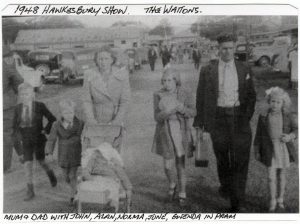
Empire night was something special – us kids would for months before the night go into the bush and cut down various sized trees and lug them home to a paddock for them to dry out. This took a long time and was hard work. Mum and Dad both helped us to construct the bonfire and to build it as large as we could. We and our friends would have a great night particularly when letting of our fireworks and crackers. In those days everyone was sensible and no stupidity occurred.
Most times we would buy crackers from little monies earned by running errands for neighbours, cleaning out fowl houses, picking up and bagging potatoes and the like.
I attended Richmond High School for four years (1952-1955) and can remember the “dicey” crossing over the two viaducts between Mulgrave and Clarendon. During flood times the water would be lapping the underside of the tracks and six metres plus of water under the bridges. I don’t think safety was thought of by the NSW Rail Dept. in those years.
During my time at High School, sports were my main love, particularly cricket and rugby league in which I represented the school against other schools.
Dad was also a keen cricketer in his early years and his genes must have passed down the line to his three sons because all of us became very much involved with cricket for years to come. When I was about 12 or 13 I was captain of the Riverstone Junior cricket team and remained there for the next three years. Unfortunately we could not win a final – Windsor always had the wood on us. From 16 years of age I was in a very good side captained by Ron Brown for the Riverstone RSL and played in the Parramatta competition. We had some very good players in those years such as Colin Haywood, Bob Brennan, Bob (Bingo) Webster, Ron Brown, Manny McCarthy and others.
Unfortunately a car accident in early 1959 put a stop to all my sports including rugby league (I was playing ‘A’ Reserve at the time) for a long time. Ligaments in my right foot rolled up into a ‘ ball’ and I had to be very careful with what I did.
In the years to come Alan and Colin excelled in cricket playing with the Riverstone & Schofields clubs and rugby league for Riverstone Football Club, wherein they were runners up in the ‘A’ Grade grand final in 1970 and winning in 1971 and 1972 against Mt. Druitt and Windsor respectively. Colin previously represented NSW School Boys in Rugby League and cricket against Queensland in 1961.
After completing High School I gained employment with Bill McNamara in the start of 1956 after asking him if there was an apprenticeship for carpentry and joinery open. I remember asking him one Saturday morning on the corner opposite the Station Master’s residence. He immediately said “What do you know about hammers, saws and wood”. I replied that I had been playing around with these tools since I was seven years of age and I liked doing things with wood.
Bill in his wisdom decided to give me a start the following week at Richmond Aerodrome. My first job was working on the Airman’s Quarters and Ablution Block with Jimmy Hanney under the control of our foreman Peter Rosa. Thereafter, I remained in Bill’s employment with W. McNamara Pty. Ltd. (later changed to the McNamara Group) for the next 37 years in which I was involved with many large projects within in NSW and Qld and at various levels of management and became General Manager of Construction in 1987.
After the McNamara Group decided to close operations I continued my time with Bill in our joint company, Metro West Pty. Ltd. in 1993 for the next 10 years until I decided to retire and do some travelling while still reasonably young.
It wasn’t the end of our Association as I am still involved with Bill in various types of discussions and matters and in touch with him on a regular basis. I enjoyed my entire time in the building industry despite several awkward times with union disturbances.
Alan and Colin also both worked for The McNamara Group on several projects for a long period of time and again on large projects. Alan was Centre Manager of Westpoint Marketown.
My sister Norma was married to Brian Watts (Long’un) and he also worked for Bill for 30 odd years but unfortunately passed away in 2000. June my middle sister is married to well known Rivo identity Barry (Muzzo) Wood and my youngest sister, Gwenda married Frank Whitehead (deceased 2015).
During September 1970 Dad suffered a major cerebral stroke at home and remained hospitalised and cared for until he passed away in July 1974. Mum would visit him every day and each of us siblings would see him in turn on a weekly basis. Dad was 71 years of age. Over the next 21 years Mum lived by herself at home and was visited by all members of the family at various times, but doing it tough with constant pain and without her partner in life.
In August 1992 at the age of 80 years Mum suffered an inoperable tumour on the brain and passed away peacefully in Lottie Stewart Hospital.
Despite the sad times that happen throughout life to us all, we loved our time growing up and living our lives, building our homes and raising our children in Riverstone. Some of us have now left the town but still think very fondly of the good times we had there and often revisit to catch up with sisters, brothers and life long friends.
Photos: The Watton family.

